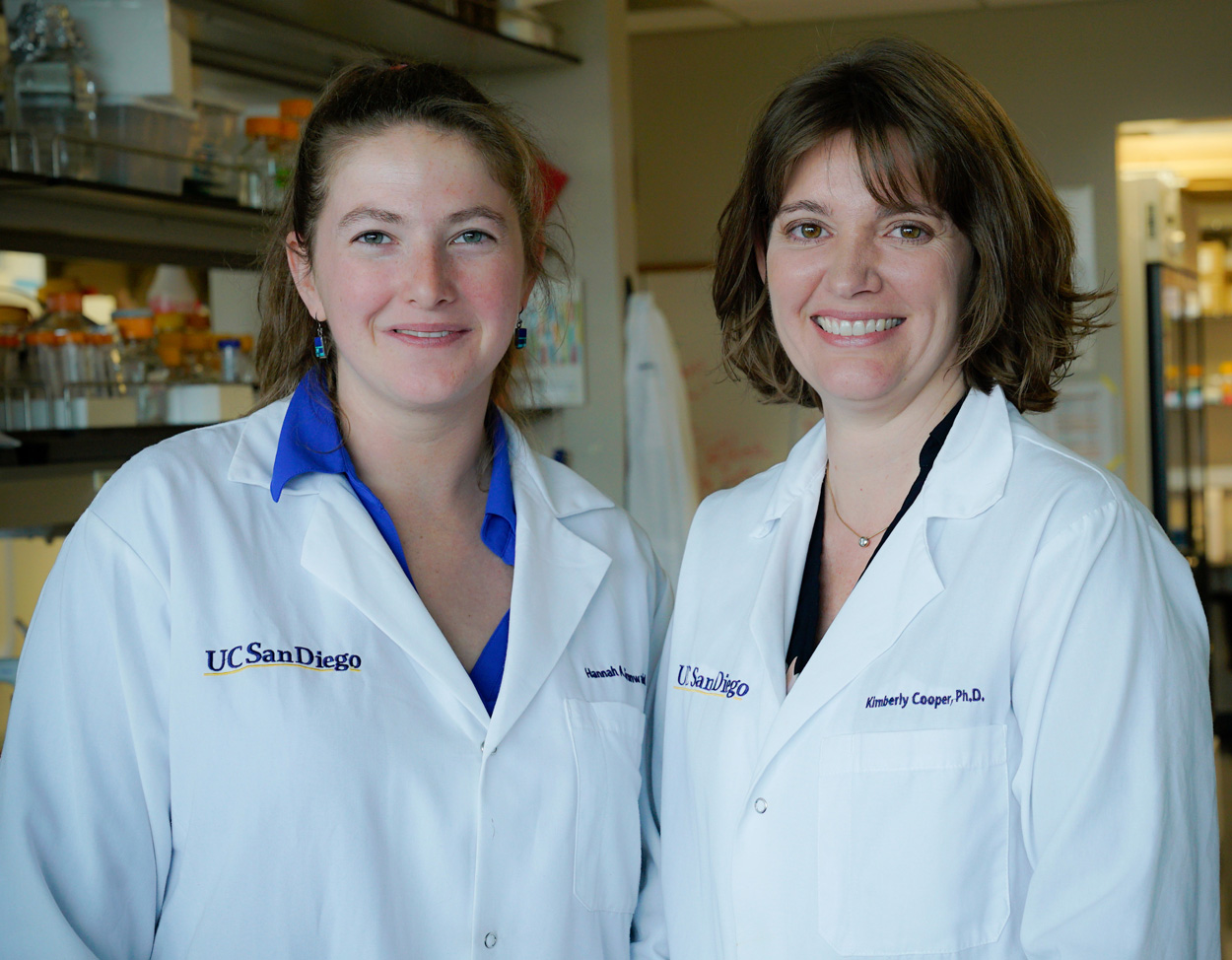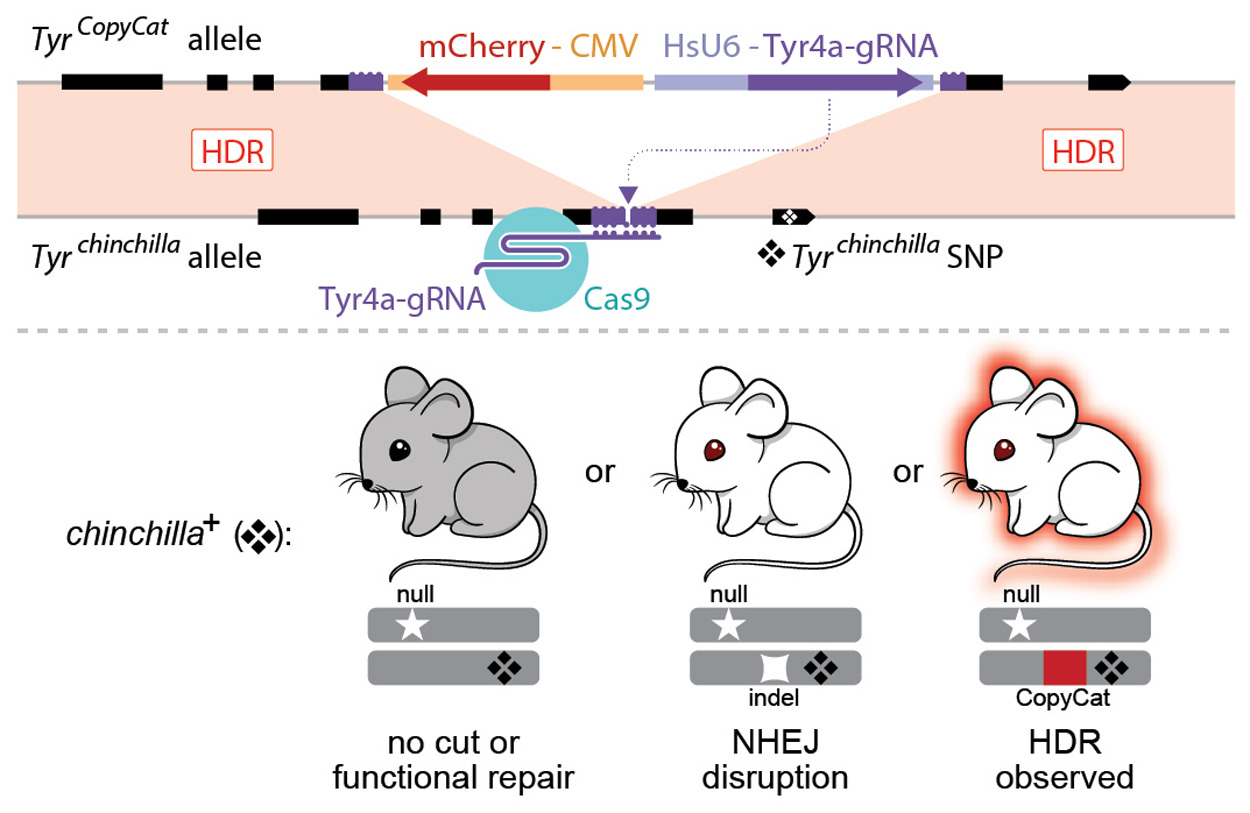UC San Diego Researchers First to Use CRISPR/Cas9 to Control Genetic Inheritance in Mice
Technology offers powerful new genetic tools for human disease research in rodents
January 23, 2019
By Mario Aguilera

Biological Sciences graduate student Hannah Grunwald and Assistant Professor Kimberly Cooper
Biologists at the University of California San Diego have developed the world’s first CRISPR/Cas9-based approach to control genetic inheritance in a mammal.
Scientists around the world have been using CRISPR/Cas9 in a variety of plant and animal species to edit genetic information. One approach to editing the genome can control which of the two copies of a gene is passed to the next generation. While such “active genetics” approaches have been developed in recent years in insects, creating such tools in mammals is more challenging, and testing them takes much longer due to the longer time between generations.
Publishing their work January 23 in the journal Nature, a joint team of UC San Diego researchers developed a new active genetic technology in mice. The achievement of UC San Diego graduate student Hannah Grunwald, Assistant Researcher Valentino Gantz and colleagues led by Assistant Professor Kimberly Cooper, lays the groundwork for further advances based on this technology, including biomedical research on human disease.
“Our motivation was to develop this as a tool for laboratory researchers to control the inheritance of multiple genes in mice,” said Cooper. “With further development we think it will be possible to make animal models of complex human genetic diseases, like arthritis and cancer, that are not currently possible.”
To demonstrate feasibility in mice, the researchers engineered an active genetic “CopyCat” DNA element into the Tyrosinase gene that controls fur color. When the CopyCat element disrupts both copies of the gene in a mouse, fur that would have been black is instead white, an obvious readout of the success of their approach. The CopyCat element also was designed so that it cannot spread through a population on its own, in contrast with CRISPR/Cas9 “gene drive” systems in insects that were built on a similar underlying molecular mechanism.

UC San Diego researchers used CRISPR/Cas9 to control genetic inheritance in mammals for the first time.
Over the two-year project period, the researchers used a variety of strategies to determine that the CopyCat element could be copied from one chromosome to the other to repair a break in the DNA targeted by CRISPR/Cas9. As a result, the element that was initially present on only one of the two chromosomes was copied to the other chromosome. In one of the families, as many as 86 percent of offspring inherited the CopyCat element from the female parent instead of the usual 50 percent.
The new approach worked in female mice during the production of eggs, but not during the production of sperm in males. This is possibly due to a difference in the timing of male and female meiosis, a process that normally pairs chromosomes to shuffle the genome and may assist this engineered copying event.
According to UC San Diego Professor Ethan Bier, a study coauthor, the results “open the way for various applications in synthetic biology including the modular assembly of complex genetic systems for studying diverse biological processes.”
Cooper and members of her lab are now springboarding off this first mammalian active genetic success—based on a single gene—and attempting to expand the tool to multiple genes and traits.
“We’ve shown that we can convert one genotype from heterozygous to homozygous. Now we want to see if we can efficiently control the inheritance of three genes in an animal. If this can be implemented for multiple genes at once, it could revolutionize mouse genetics,” said Cooper.
While the new technology was developed for laboratory research, some have envisioned future gene drives that would build on this approach in the wild for efforts to restore the balance of natural biodiversity in ecosystems overrun by invasive species, including rodents.
“With additional refinements, it should be possible to develop gene-drive technologies to either modify or possibly reduce mammalian populations that are vectors for disease or cause damage to indigenous species,” said Bier.
However, these data also indicate that technical improvements needed for practical use in the wild allow time for careful consideration of which applications of this new technology could and should be implemented. The researchers note, however, that their results demonstrate a substantial advance that might already decrease the time, cost and number of animals needed to advance biomedical research on human diseases and to understand other types of complex genetic traits.
“We are also interested in understanding the mechanisms of evolution,” said Cooper. “For certain traits that have evolved over tens of millions of years, the number of genetic changes is greater than we can currently assemble in mice to understand what caused bat fingers to grow into a wing, for example. So we want to make lots of these active genetic tools to understand the origins of mammalian diversity.”
Former UC San Diego Postdoctoral Fellow Gunnar Poplawski (co-first author, now at the National University of Singapore) and Staff Research Associate Xiang-ru Xu also contributed to the study.
Funding for the research came from a variety of sources, including: A Searle Scholar Award from the Kinship Foundation, a Pew Biomedical Scholar Award from the Pew Charitable Trusts, a Packard Fellowship in Science and Engineering from the David and Lucile Packard Foundation, the National Institutes of Health (NIH) (R01 GM117321), a Paul G. Allen Frontiers Group Distinguished Investigators Award, the Tata Trusts in India to the Tata Institute for Genetics and Society-UC San Diego and Tata Institute for Genetics and Society-India, a Ruth Stern Graduate Fellowship, the NIH Cell and Molecular Genetics training grant (T32 GM 7240 - 39A1) and NIH (DP5 OD023098).
